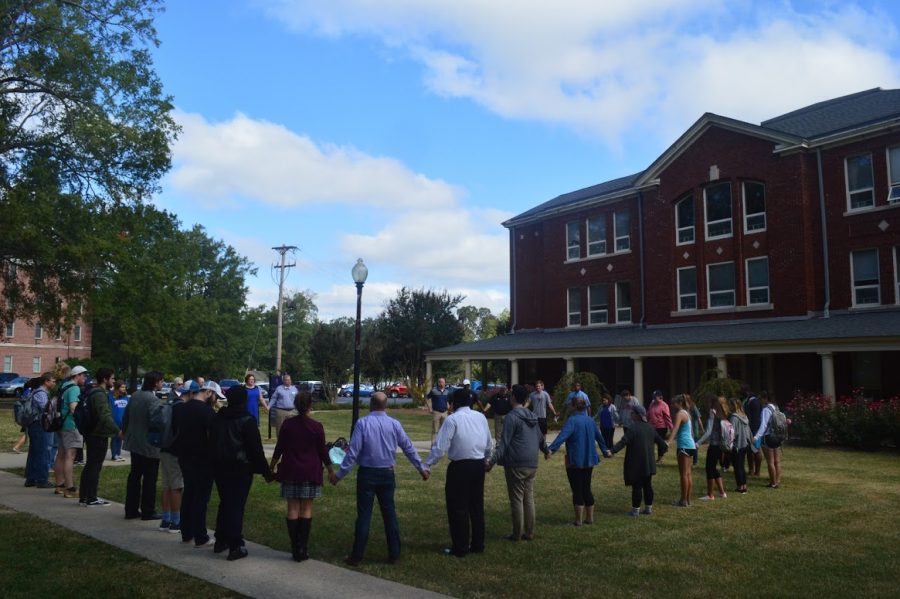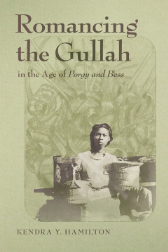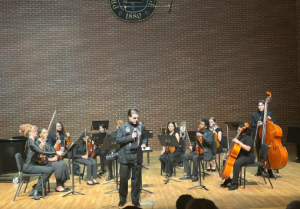Students Participate in Demonstration for Black Lives Matter
PC students, faculty and staff hold hands in silence in a demonstration of support for the Black Lives Matter movement. | Photo courtesy of Lashawna Wright.
October 30, 2016
After an exceptionally blistering summer, the morning of October 6 was surprisingly brisk. Most people went without coats, and when the wind blew, they started shivering. But none of the fifty-six people, of varied race, age and gender, left early. For fifteen minutes they stood in front of Springs Student Center, linking hands in a demonstration of support for the Black Lives Matter (BLM) movement.
Before I go any further, let me be honest: I’m not unbiased. I participated in the demonstration because I fully support the ideas behind the BLM movement. It would be wrong for me to try and hide it. So please remember that I write this article from that viewpoint.
Junior Jacob Kennedy from the Christian Education Program and senior Joaquin Ross from the Multicultural Student Union organized the event.
“It stemmed from ideas and conversations had amongst students in Dr. Becky Davis’s Race and Social Ethics class and MSU meetings,” said Kennedy.
Kennedy, who also spoke at the National Coming Out Day Service on campus, says his religion plays a huge role in why he chooses to engage in social justice.
“My faith is what inspires me…I believe God is a God of love and peace. Through my being active in social justice, I’m seeking to create heaven on Earth.”
The organizers confessed that they expected ten people, and hoped that maybe, at most, thirty would show. Instead, almost twice as many turned out. The circle, made up of students, professors and faculty members, was so large that it blocked the sidewalks, forcing pedestrians to take detours into the grass. The inconvenience, while small, was a classic civil rights strategy; it was a way to grab people’s attention.
Among the demonstrators was Dr. Erin McAdams, a professor from the Political Science department. “I was inspired to participate in this public witness because I support the Black Lives Matter movement and what it stands for – an end to the systemic racism and injustices that African Americans face in our society, particularly police brutality,” she said.
Dr. McAdams, whose area of focus is American Government and Politics, went on to say, “I’ve been thinking a lot lately about something that Dr. King wrote…that the greatest “stumbling block” in obtaining racial equality was not the KKK or other white supremacy groups, “but the white moderate who is more devoted to ‘order’ than to justice…who constantly says ‘I agree with you in the goals you seek, but I cannot agree with the methods’…”
Afterwards, the demonstrators moved to HP for a discussion on the demonstration and the BLM movement more broadly. Several members of PC’s administration were present, such as President Bob Staton, who complimented the students on their efforts, and Director of Campus Police Larry Mulhall. Participants discussed how social media has been a tool for spreading awareness about social justice issues as well as ignorance and misinformation. Head Baseball Coach Elton Pollock, I believe, summarized what fueled the BLM movement best: “I just want to get home safe. I don’t want to be killed for a traffic stop.”
The dialogue was respectful, with no raised voices or angry interruptions. It was a stark contrast to most current conversations on race and politics. It makes one wonder why the people running for the highest office of this country can’t act with similar decorum. At the end, Joaquin Ross thanked everyone for participating, and stated he hoped to see similar participation in future events.
“I do believe PC tries to be inclusive,” Ross said later in an e-mail. “However, there are certain tensions that keep certain individuals from feeling included.”
While he didn’t have an immediate answer to this problem, he spoke of a hope for cooperation that characterized all his statements:“I want the whole student body and faculty and administration to help me find an answer,” he said.






